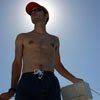I found this basic but useful information (I can't remember where I got it). This was all I needed.

Aperture gives photographers a chance to make quick, easy and attractive web sites full of photos. But for some photographers, the standard choices that ship with Aperture are not enough.
You can build your own templates or customize the ones that ship with Aperture if you know HTML and/or CSS. Here’s a very basic guide on how to make your own Aperture web templates.
1) Locate the Aperture Package (by default this is in your Applications Folder.)
2) Control-click on the package and select SHOW PACKAGE CONTENTS. Then open the Folder called CONTENTS and navigate to RESOURCES/WEB THEMES.
3) Select one of the existing themes to use as a model. For the purpose of this posting, go to ART COLLECTION by double-clicking and opening that Folder. Make a duplicate of that Folder so you don’t mess up the default choices. (Right-Click or Control-click and select 'Duplicate')
4) Inside your duplicated ART COLLECTION you will see another Folder called English.lproj. Open that Folder by double clicking it.
5) Modify the HTML pages you see here as you see fit. As I said earlier, you will need to know HTML and/or CSS. You can modify the name of the theme by opening the file 'Localizable.strings' in TextEdit and changing the variable there.
6) After making basic HTML and CSS changes, you may want to go further and customize the images that go with the theme. They are found in the assets:img Folder. Here you’ll find all of the images that are used as navigation icons. You can edit these in a graphics program like Photoshop or you can replace them with your own.
7) If you want Aperture to display an icon that represents your custom theme, you’ll have to create it yourself. It needs to 90×105 pixels and saved with the name THUMBNAIL.TIFF. Place this file inside your new theme folder.
8) Once you’ve made your modifications, be sure to save them in the appropriate places and then drag the new or modified theme into the WebThemes folder inside the Aperture Package. You won’t see the theme until you quit and re-start Aperture.
9) Save your theme in a backup location, since installation of Aperture updates may overwrite your WebThemes folder, rendering all your customization worthless.
This is in no way meant to be a tutorial or detailed article on how to customize Aperture web themes, but if you are like me, this is all you need to do everything else.

No comments:
Post a Comment